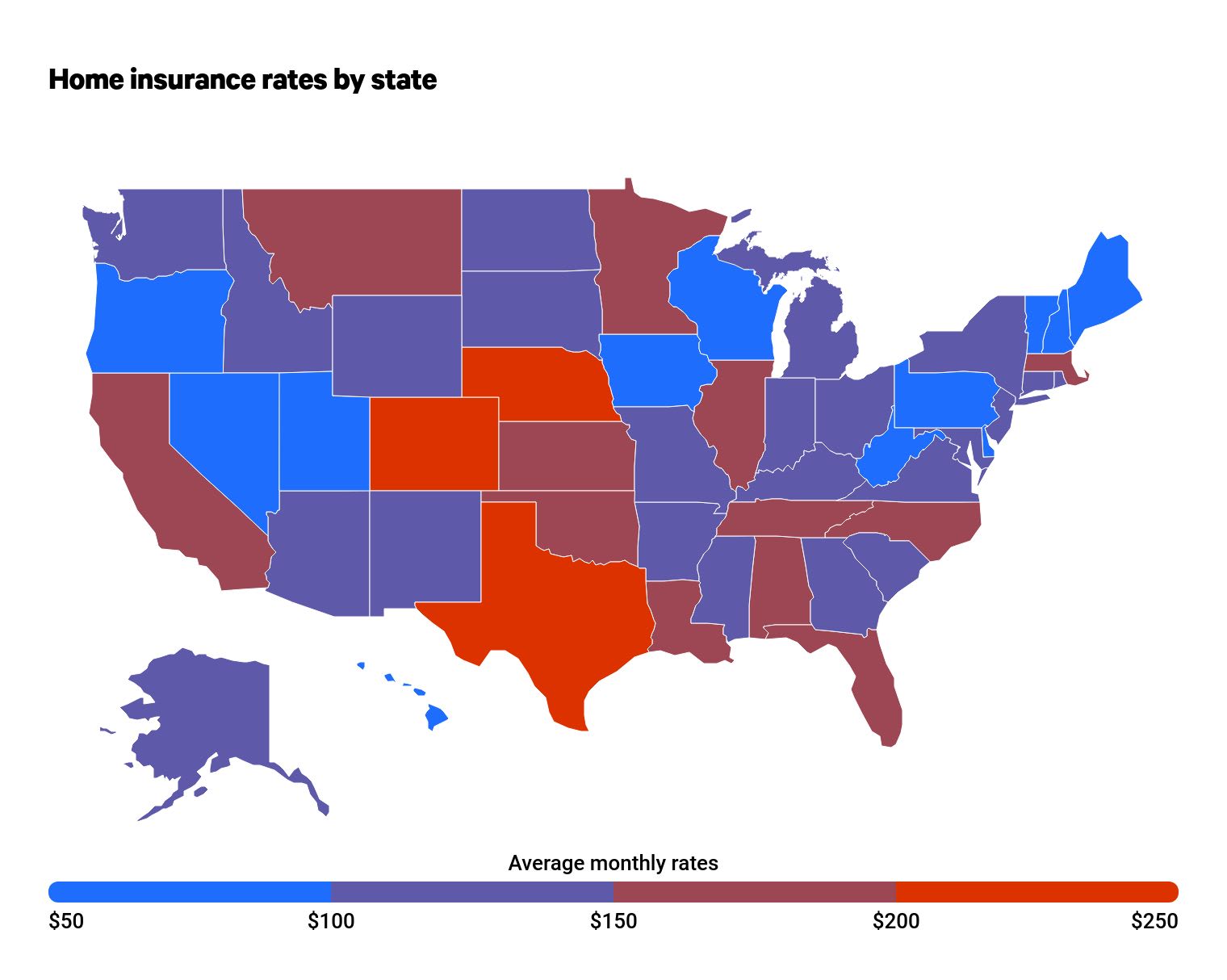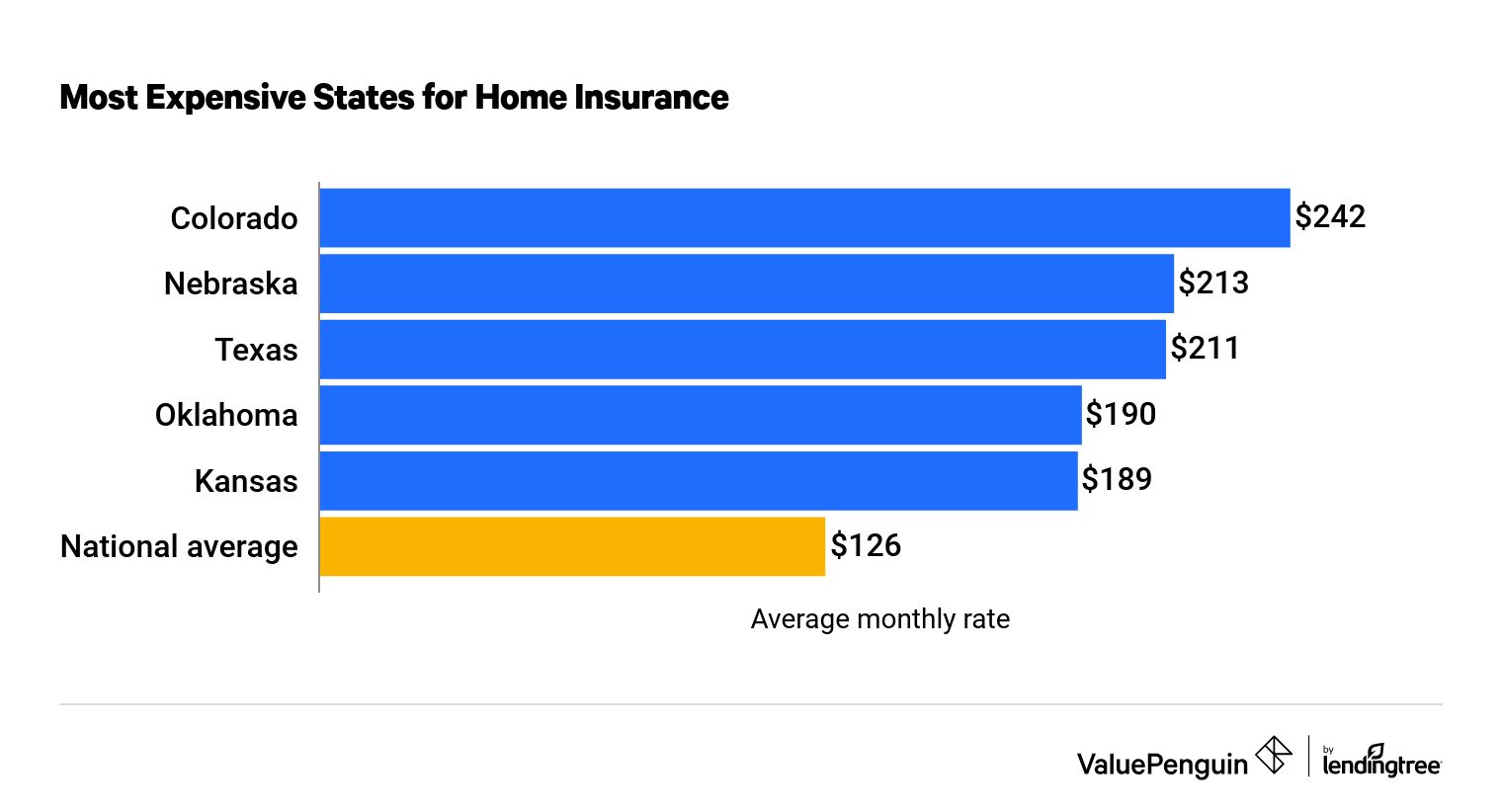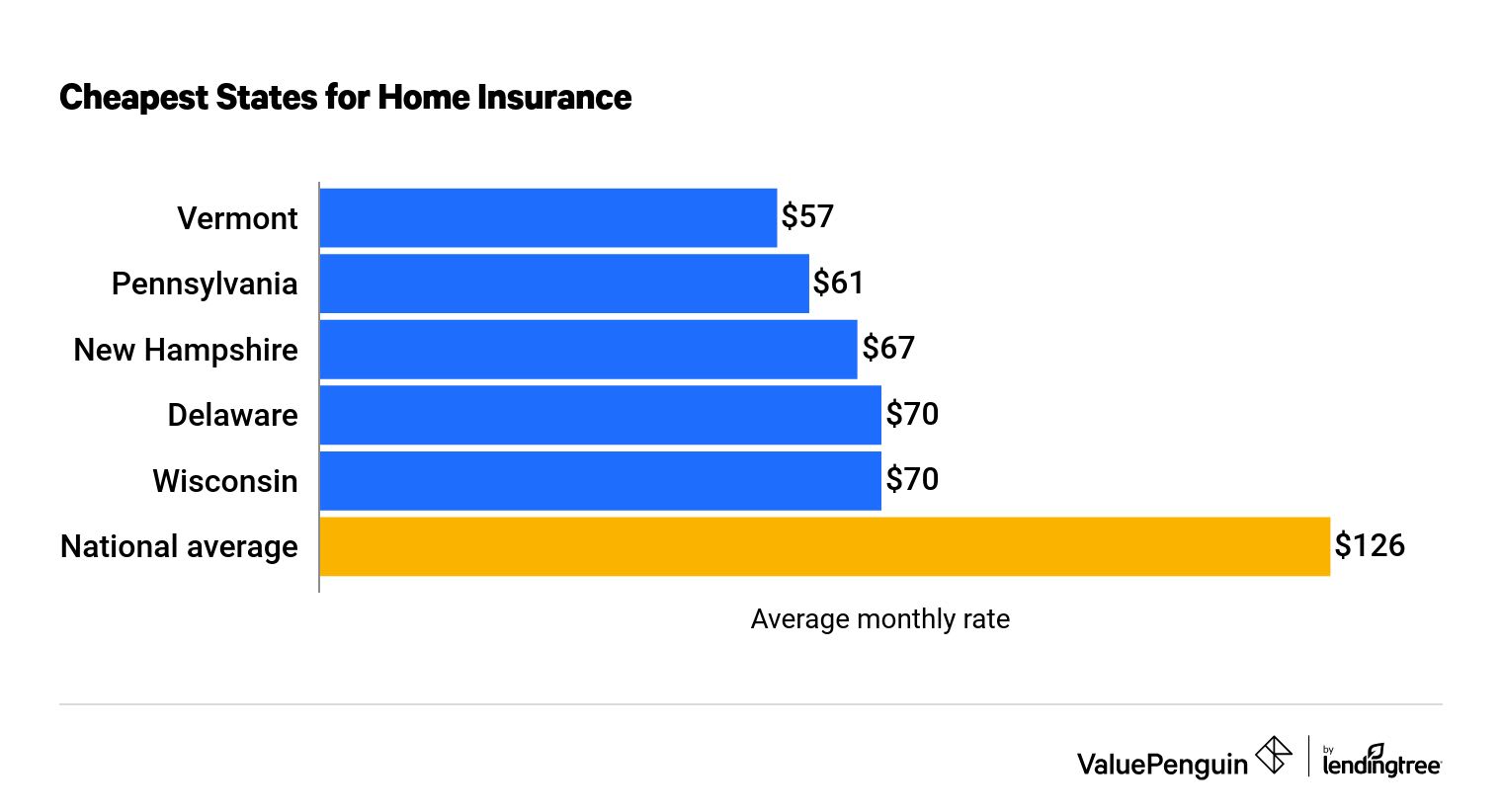Average Cost of Homeowners Insurance (2023)
The average cost of home insurance in the United States is $126 per month, or $1,516 per year.
Find Cheap Homeowners Insurance Quotes in Your Area
What's next
ValuePenguin collected and studied hundreds of thousands of quotes from every ZIP code across the country to find the average homeowners insurance rates in every state. Each policy is for a 2,100-square-foot home of the average age and value in the state where it's located.
Average home insurance rates by state
Home insurance costs an average of $126 per month in the United States, but prices vary greatly by state.
The average cost of home insurance ranges from $57 to $242 per month, depending on which state you live in. A policy in Vermont, the least expensive state, costs $57 per month, while coverage in Colorado, the most expensive state, costs $242 per month.

Find Cheap Homeowners Insurance Quotes in Your Area
Average cost of homeowners insurance by state
State | Annual rate | Monthly rate |
|---|---|---|
| Alabama | $2,021 | $168 |
| Alaska | $1,307 | $109 |
| Arizona | $1,614 | $134 |
| Arkansas | $1,531 | $128 |
| California | $1,839 | $153 |
Individual state averages are based on the median home value in each state, which we used as an approximation of the cost to rebuild the home.
Differences in state averages are caused by several factors, including the unique home insurance risks for each state and the amount of coverage a typical homeowner buys in each state. Your own rates may differ from the state average, as well.
Which states pay the most for home insurance coverage?
The states with the highest home insurance costs are generally where natural disasters occur often.
Colorado leads the pack, with wildfires pushing prices much higher than the national average. Texas is the third-most expensive state, partly due to hurricanes and tornadoes in the state.
Nebraska, Oklahoma and Kansas round out the top five most expensive states for home insurance. Homeowners in these five states spend 49% more per year on home insurance than the typical U.S. resident.
Which states pay the least?
Vermont, Pennsylvania, New Hampshire, Delaware and Wisconsin are the cheapest states for home insurance. These states tend to have fewer natural disasters, lower home values or both.
The average cost of insurance for a typical home in these states is less than $71 per month. On average, homeowners in these states pay 44% less than the average price nationwide.
How is home insurance calculated?
Insurance companies look at many factors when determining how much to charge for home insurance. These are either fixed factors that are unchangeable, like the year your home was built, or adjustable factors you can control, like whether your roof is weatherproof.
Factors you can control that affect home insurance rates
Other factors that affect home insurance rates
How can you reduce the cost of your homeowners insurance?
There are three main ways to lower your insurance costs:
- The best, easiest way to reduce your homeowners insurance cost is to get quotes from multiple insurance companies. It's especially easy to do this when your policy is up for renewal or if you've made major changes to your policy.
- Another option is to raise your deductible — the amount you pay before insurance kicks in. A higher deductible directly results in a lower rate. However, you should only raise your deductible to an amount you can afford to pay if you experience a loss. If you couldn't afford an unexpected $5,000 expense, you should keep your deductible below that amount.
-
Lastly, be sure to ask about homeowners insurance discounts. While discounts vary from company to company, some common ones include:
- Multipolicy discounts
- Claim-free discount
- Loyalty discount
- Home safety discount
- Roof discount
- Retiree discount
What does homeowners insurance cover?
If you want to lower your rates, you need to know what your homeowners insurance policy covers in the first place. Individual policies will differ, but most consist of four standard coverages:
Dwelling coverage pays for the cost of repairs or replacement if your home’s structure is damaged by a covered event.
- Roofing
- Walls
- Floors
- Foundation
- Built-in appliances
- Garages, sheds and other structures (usually)
Personal property coverage protects the contents of your home from any damage caused by a covered peril. A standard HO-3 policy will usually include coverage for:
- Furniture
- Clothing
- Electronics
- Jewelry
Liability coverage deals with your legal liability for property damage or bodily injury to others in various situations.
- Legal expenses if your dog bites a guest and you are sued
- Legal expenses if your tree falls and damages your neighbor's roof
- Repairs to your neighbor's window if you break it while playing ball
Loss of use coverage covers any expenses you incur while living away from your home if it's made uninhabitable by covered damage.
- Cost of living in a hotel or motel
- Cost of meals out while living in temporary housing without a kitchen
- A credit check fee for renting out a temporary home
- Transportation reimbursement for increased mileage to your workplace
Frequently asked questions
How much is homeowners insurance?
The average cost of home insurance across the United States is $1,516 per year, or $126 per month. Rates can vary by $185 per month, depending on which state you live in.
How is homeowners insurance calculated?
A number of factors determine your home insurance rate. Some of the most important are where your home is located, your claims history, the amount of coverage you buy and your home's building materials.
Why did my home insurance go up?
Your home insurance may be more expensive for a few reasons. If you recently filed a home insurance claim, your insurance company may raise your rates to protect themselves against future claims. Your credit score also affects your home insurance rate, so you may have a higher home insurance bill if your credit score has gone down. You could also see an increase if the cost of building materials goes up or your area experiences natural disasters often.
How much does home insurance cost in Florida?
Homeowners in Florida can expect to pay $184 per month, or $2,207 per year, on average. That doesn't include the cost of flood insurance, which many Floridians need. Florida is the sixth-most expensive state for home insurance in the U.S.
Methodology
We collected home insurance rates for every residential ZIP code in the United States, from the largest homeowners insurance companies in every state.
For each state average, we collected rates corresponding to the median home age and value for the state. For example, our sample home in California was built in 1975 and has $505,000 of dwelling coverage. Meanwhile, our sample West Virginia home was built in 1974 and has $119,500 of dwelling coverage. We used median home values to approximate the rebuild cost in each state.
ValuePenguin's analysis used insurance rate data from Quadrant Information Services. These rates were publicly sourced from insurer filings and should be used for comparative purposes only — your own quotes may be different.


